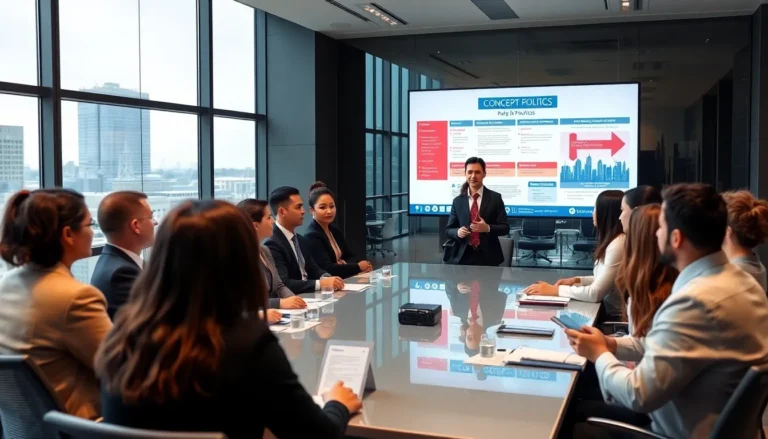Unlocking an iPhone from its carrier can feel like trying to crack a safe with a toothpick. Many users find themselves tied to their service provider, but the good news is that freedom is just a few steps away. Imagine being able to switch carriers without the hassle of buying a new phone or dealing with endless contracts.
Table of Contents
ToggleUnderstanding iPhone Carrier Locking
Carrier locking restricts an iPhone to a specific mobile network provider. Many carriers apply this lock to ensure customers fulfill contract obligations before unlocking devices. Users face limitations when attempting to switch carriers, impacting service choices and pricing plans.
Unlocking an iPhone allows users to connect to other networks. Certain parameters affect the unlock process, including the carrier, account standing, and device eligibility. Carriers maintain different policies for unlocking, with some offering straightforward options while others impose specific conditions.
Many carriers require users to complete their contracts. The completion of payment obligations often serves as a prerequisite for unlocking. Additionally, users must ensure their devices are not reported lost or stolen, as this status prevents unlocking.
Devices bought directly from carriers generally remain locked. In contrast, iPhones purchased from authorized retailers may come unlocked. Checking the phone’s lock status contributes to understanding available options for unlocking.
Unlocking an iPhone benefits users by enhancing flexibility. With an unlocked device, individuals can travel internationally and switch carriers for better deals. Solutions vary among carriers, often involving a request via online forms or customer service.
Understanding the carrier unlock process helps streamline the transition. Familiarity with specific steps and requirements enhances the experience. Gathering necessary information simplifies communication with the carrier, ensuring a smoother unlocking journey.
Benefits of Unlocking Your iPhone

Unlocking an iPhone provides several advantages that enhance user experience. Users gain greater control over their devices and have the freedom to choose service providers that best meet their needs.
Increased Flexibility
Flexibility becomes a key benefit when an iPhone is unlocked. Travelers can switch to local carriers while abroad, avoiding high roaming charges. Users also have the ability to select plans that offer better pricing options and network coverage. They gain access to various prepaid or contract plans that some carriers provide. Switching between carriers simplifies optimizing service based on personal requirements and preferences.
Enhanced Resale Value
An unlocked iPhone often commands a higher resale value compared to a locked counterpart. Buyers prefer devices that allow them to use any carrier, recognizing the convenience it offers. Increased interest in unlocked devices leads to faster sales and higher offers. Reselling an iPhone becomes more appealing, especially if it’s in good condition, as potential buyers value the freedom to choose. Enhancing resale value generates potential additional profits for users upgrading to newer models.
How to Unlock iPhone From Carrier
Unlocking an iPhone from a carrier can enhance user flexibility and broaden options for mobile service. Multiple methods exist to complete this process, but official carrier unlocking remains the most reliable.
Official Carrier Unlocking
Most carriers offer an official unlocking process through customer support. Customers typically need to provide their iPhone’s IMEI number, which can be found in the device settings. Account standing is crucial; users must ensure their account is in good condition. Contracts and payment obligations must generally be fulfilled before a request is considered.
Some carriers impose additional conditions, such as waiting a specific period after purchase. After verification, carriers usually send an unlock request confirmation via email. Once confirmed, users can connect the iPhone to iTunes or Finder to complete the unlocking. Following these steps not only ensures compliance with carrier policies but also promotes a seamless transition to other networks.
Third-Party Unlocking Services
Third-party unlocking services provide another option for users looking to unlock their iPhones. These services often advertise quick and easy solutions but may vary in reliability. Some companies specialize in unlocking devices from multiple carriers, offering competitive pricing.
Users commonly find these services online; reviews and ratings often indicate their effectiveness. It’s essential to verify the reputation of the service before proceeding. Agencies with positive feedback tend to deliver more dependable results.
Many third-party options require the iPhone’s IMEI number for the unlocking process. Customers should ensure they provide accurate information to avoid delays. Reliable services usually guarantee a quick turnaround time, allowing users to switch carriers without extensive waiting.
Not every third-party service is trustworthy, so users need to exercise caution. Researching the company’s track record can prevent potential scams. Reputable services often highlight their refund policies for users who face issues during the unlocking process.
Using a third-party service may not always be as straightforward as official carrier unlocking. Potential risks include warranty voidance or exposure to hidden fees. Users should weigh these factors before choosing this route, especially if they rely on their device for crucial tasks.
Ultimately, third-party unlocking services can offer a feasible solution for many individuals. Balancing convenience and safety helps users make informed decisions when exploring this option.
Troubleshooting Common Issues
Users often face challenges during the unlocking process. Understanding common issues can help streamline the experience.
Error Messages
Error messages frequently occur when users attempt to unlock their iPhones. These messages might indicate an incorrect IMEI number or issues with account eligibility. If a user sees the “SIM Not Supported” error, it usually means the phone has not been unlocked yet. Some carriers also display error codes that provide insights into specific problems like unpaid balances or contract obligations. Double-checking the IMEI number and ensuring the account meets all unlock requirements often resolves these issues. Additionally, contacting the carrier’s customer service can clarify error messages and provide further troubleshooting steps.
Network Problems
Network problems may arise after unlocking an iPhone. Users often report network connectivity issues, including dropped calls or inability to access data. Switching to a new SIM card may resolve these issues, ensuring compatibility with the new carrier. Users should also verify that the new carrier’s network is available in their area. In some cases, resetting network settings on the iPhone can fix connectivity problems. To do this, navigate to Settings, select General, and tap Reset. After resetting, reconnecting to Wi-Fi and mobile networks is essential for restoring service.
Unlocking an iPhone from a carrier opens up a world of possibilities for users. It allows them to switch networks and choose plans that better fit their needs. With the right approach and understanding of the unlocking process, users can navigate the challenges effectively.
Whether opting for official carrier unlocking or considering third-party services, it’s crucial to weigh the benefits against potential risks. Staying informed about eligibility requirements and troubleshooting common issues can lead to a smoother experience. Ultimately, the freedom to use an unlocked iPhone enhances flexibility in service choices and can even increase resale value, making it a worthwhile endeavor for many users.





